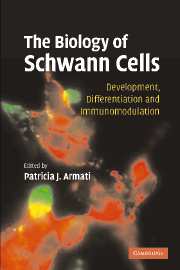Book contents
- Frontmatter
- Contents
- Preface
- Contributors
- 1 Introduction to the Schwann cell
- 2 Early events in Schwann cell development
- 3 The molecular organisation of myelinating Schwann cells
- 4 The role of the extracellular matrix in Schwann cell development and myelination
- 5 The biology of perisynaptic (terminal) Schwann cells
- 6 Cytokine and chemokine interactions with Schwann cells: the neuroimmunology of Schwann cells
- 7 Schwann cells as immunomodulatory cells
- 8 Mutations in Schwann cell genes causing inherited neuropathies
- 9 Guillain–Barré syndrome and the Schwann cell
- 10 Chronic idiopathic demyelinating polyneuropathy and Schwann cells
- References
- Index
- Plate section
5 - The biology of perisynaptic (terminal) Schwann cells
Published online by Cambridge University Press: 13 August 2009
- Frontmatter
- Contents
- Preface
- Contributors
- 1 Introduction to the Schwann cell
- 2 Early events in Schwann cell development
- 3 The molecular organisation of myelinating Schwann cells
- 4 The role of the extracellular matrix in Schwann cell development and myelination
- 5 The biology of perisynaptic (terminal) Schwann cells
- 6 Cytokine and chemokine interactions with Schwann cells: the neuroimmunology of Schwann cells
- 7 Schwann cells as immunomodulatory cells
- 8 Mutations in Schwann cell genes causing inherited neuropathies
- 9 Guillain–Barré syndrome and the Schwann cell
- 10 Chronic idiopathic demyelinating polyneuropathy and Schwann cells
- References
- Index
- Plate section
Summary
There are four classes of Schwann cells in the mature vertebrate nervous system: (1) myelinating Schwann cells, which wrap around large-diameter axons including motor axons; (2) non-myelinating Schwann cells, which associate with small-diameter axons of many sensory and all postganglionic sympathetic neurons; (3) satellite cells of peripheral ganglia; and (4) non-myelinating perisynaptic Schwann cells (PSCs), also known as terminal Schwann cells, which cap the nerve terminal at the neuromuscular junction (NMJ) (Corfas et al. 2004). While the role of motor and sensory axon-associated Schwann cells in saltatory conduction has been well-acknowledged and characterised, relatively little is known about the role of the synapse-associated Schwann cells. However, in the past decade, there has been widespread interest in unraveling the role of Schwann cells in peripheral synapses as well as the role of astrocytes in central synapses. Extensive studies on synapse–neuroglial interactions in both the peripheral nervous system (PNS) and central nervous system (CNS) have led to the concept of the tripartite synapse (Araque et al. 1999; Volterra et al. 2002; Kettenmann and Ransom 2005). The emerging concept suggests that neuroglia cells are active and essential participants in modulating synaptic function, promoting synapse repair and development and stabilising synapses. Thus, it is no longer tenable to view the neurochemical synapse as a synaptic contact made of only the presynaptic nerve terminal and the postsynaptic target, without taking into consideration the multiple active roles of the third element, neuroglia, specifically here the PSCs.
- Type
- Chapter
- Information
- The Biology of Schwann CellsDevelopment, Differentiation and Immunomodulation, pp. 72 - 99Publisher: Cambridge University PressPrint publication year: 2007
- 7
- Cited by

